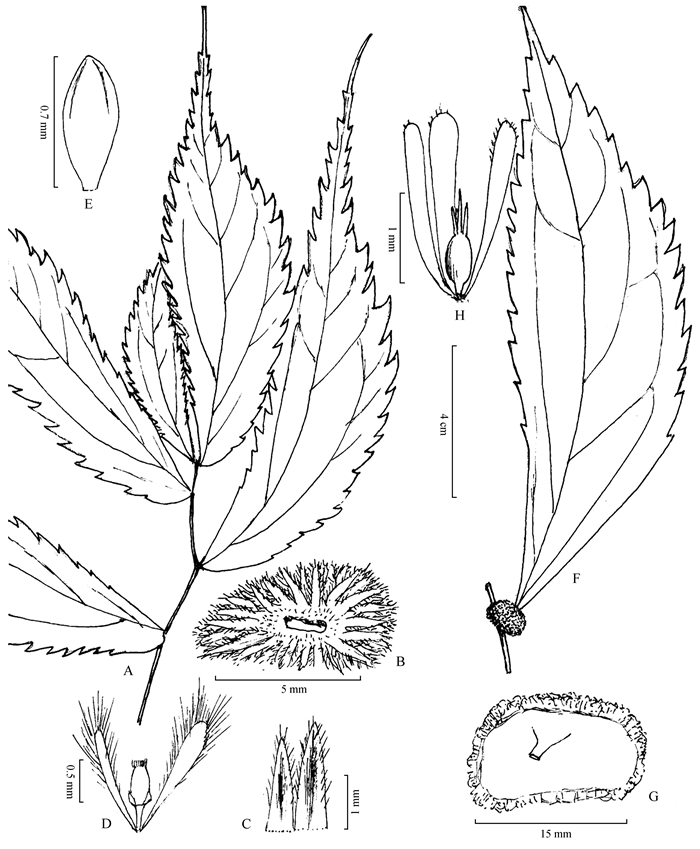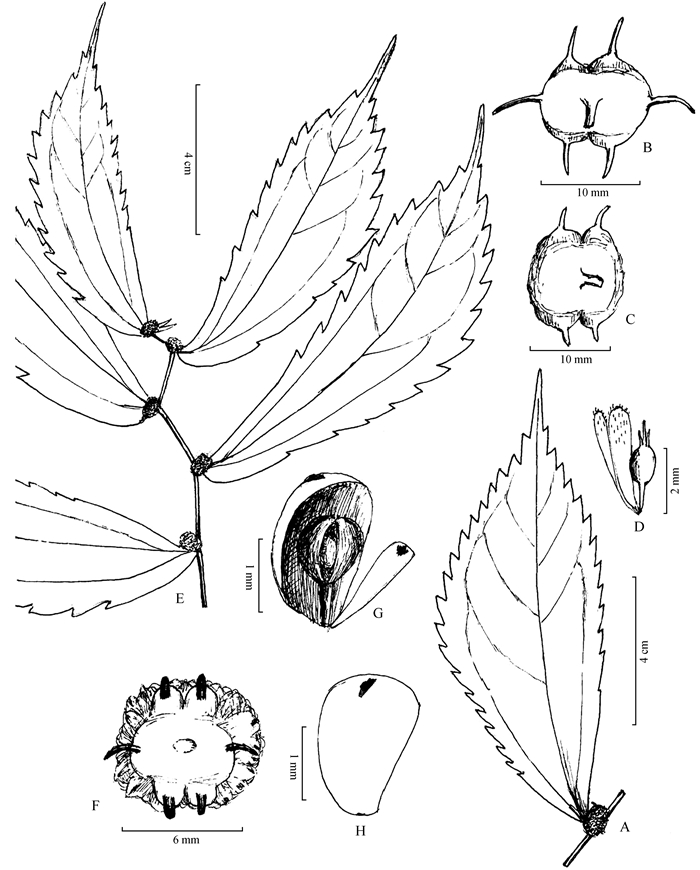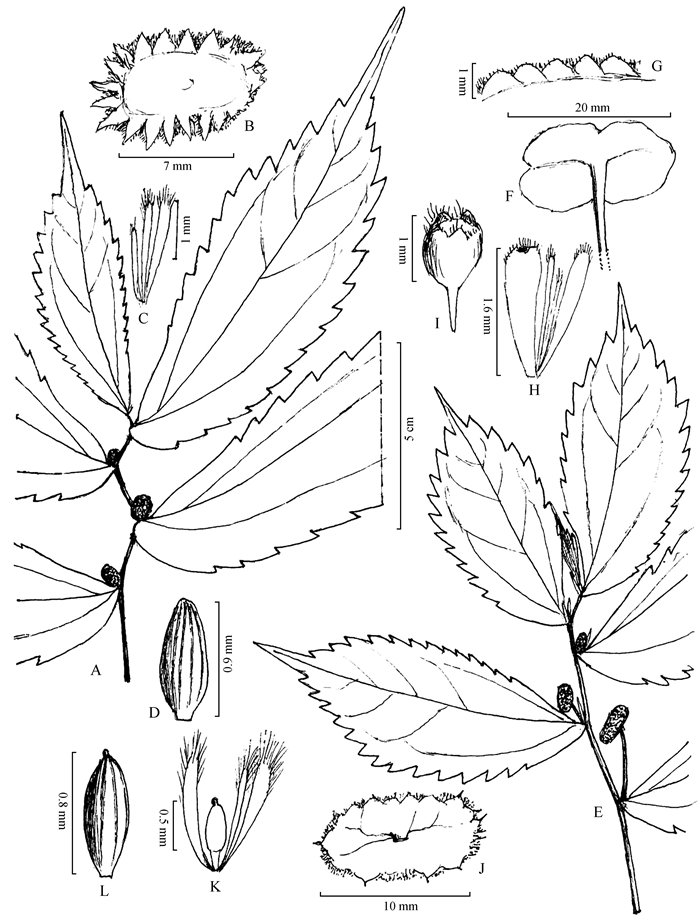2. Key Laboratory for Plant Diversity and Biogeography of East Asia, Kunming Institute of Botany, Chinese Academy of Sciences, Kunming 650201, China
©2016, Kunming Institute of Botany, Chinese Academy of Sciences. Production and hosting by Elsevier B.V. on behalf of KeAi Communications Co., Ltd. This is an open access article.
Elatostema dentatocaudatum W.T. Wang & Zeng Y. Wu, sp. nov. Fig. 1: A-E

|
Fig 1 - A-E. Elatostema dentatocaudatum A. apical part of pistillate stem; B. pistillate capitulum, seen from beneath; C. pistillate bracts; D. two pistillate bracteoles and pistillate flower; E. achene. (from holotype). F-H. E.baoshanense F. leaf and axillary staminate capitulum; G. staminate capitulum, seen from beneath; H. three staminate bracteoles and staminate flower bud. (from holotype) |
[Sect. Weddellia(H. Schröter)W.T. Wang ser. Crenata W.T. Wang]
Species nova haec est fortasse affinis E.bijiangensi W.T. Wang, quod folio apice cuspide integra et nevorum secundariorum paribus quinque praedito, capituli pistillati receptaculo majore discoideo elliptico ca. 5 mm longo, acheniis longitudinaliter 6-8-costatis, costis acheniis fere aequilongis distinguitur.
Perennial herb. Stem ca. 30 cm tall, ca. 1.2 mm diam. near base puberulous(hairs 0.1-0.2 mm long), simple, ca. 10-leaved. Leaves alternate, sessile; blades thinly papery, obliquely oblanceolate or oblong, 7-15 × 1.4-4 cm, apex caudate(tail-like apex 2-4.5 cm long, 4-8-denticulate), base at leaf narrow side obtuse, at broad side cuneate, margin dentate; surfaces adaxially sparsely strigose, abaxially glabrous; nervation penninerved, with 4 pairs of secondary nerves; cystoliths dense, inconspicuous, thinly bacilliform, 0.1-0.2 mm long; stipules membranous, greenish, narrowly lanceolate-linear, ca. 3 × 0.4 mm, glabrous. Staminate capitula and staminate flowers unknown. Pistillate capitula singularly axillary, shortly pedunculate; peduncle ca. 1 mm long, glabrous; receptacle small, inconspicuous, oblong, ca. 2 mm long, puberulous; involucral bracts ca. 16, membranous, green, narrowly triangular, 2 × 0.4-0.8 mm, puberulous; bracteoles numerous, dense, membranous, green, linear or spatulate, 1.2-2 × 0.1-0.4 mm, densely long ciliate. Pistillate flower: pedicel 0.2-0.4 mm long, glabrous; tepals 2, ovate, ca. 0.15 mm long, glabrous; ovary ellipsoidal, ca. 0.4 mm long, glabrous; stigma penicillate, ca. 0.15 mm long. Achenes brownish, ellipsoidal, ca. 0.7 × 0.4 mm, longitudinally 4-ribbed above the middle. Yunnan Province: Gongshan Xian, Dulongjiang Xiang, on the way from Kongdang to Longyuan Cun. 98°19′28.994″ E; 27°58′02.274″ N. Alt. 1 686 m. At shady places by stream. 2014-09-28. J. Liu. J.N. Lu & K. Chen GLGE 141160(holotype, PE; isotype, KUN).
This species is probably related to E.bijiangense W.T. Wang, and from the latter differs in its leaves with 4-8-denticulate long tail-like apexes and four pairs of secondary nerves, in its smaller inconspicuous pistillate receptacles, and in its achenes which only on upper part are longitudinally 4-ribbed. In E.bijiangense, the leaves at apex have entire cusps and five pairs of secondary nerves, the pistillate receptacles are larger, conspicuous, discoid, ca. 5 mm long, and the achenes are longitudinally 6-8-ribbed, with the ribs nearly as long as the achene body(Wang, 2014).
Elatostema baoshanense W.T. Wang & Zeng Y. Wu, sp. nov. Fig. 1: F-H
(Sect. Elatostema ser. Cuspidata W.T. Wang)
Species nova haec est affinis E.cuspidato Wight, quod foliis sessilibus vel subsessilibus subtus glabris, eorum cystolithis majoribus omnibus bacilliformibus 0.3-0.5 mm longis, capituli staminati bracteis involucralibus late ovatis vel depresse triangularibus apice 1-corniculatis vel crasse apiculatis, bracteolis staminatis glabris differt.
Perennial herb. Stems ca. 35 cm tall, below ca. 2 mm across, glabrous, simple, ca. 14-leaved. Leaves alternate, shor- tly petiolate; blades thinly papery, obliquely long elliptic or oblanceolate, 9-18 × 3.2-5.2 cm, apex cuspidate or acuminate, base obliquely cuneate, margin dentate; surfaces adaxially glabrous, abaxially on basal and secondary nerves puberulous(hairs 0.1-0.2 mm long); nervation semi-triplinerved, with secondary nerves 2-4 at leaf narrow side and 3-5 at broad side; cystoliths dense, inconspicuous, punctiform or shortly bacilliform, 0.1-0.15 mm long; petioles 3-10 mm long, glabrous; stipules membranous, whitish, lanceolate-linear, ca. 12 × 2 mm, glabrous, 1-greenish-nerved. Staminate capitula singularly axillary, sessile or shortly pedunculate; peduncle ca. 1 mm long, glabrous; receptacle suboblong, 10-16 × 6-9 mm, glabrous; involucral bracts few, small, inconspicuous, membranous, whitish, transversely rectangular or subquadrate, 0.8 × 1-2 mm, glabrous, apex truncate; bracteoles numerous, very dense, membranous, whitish, oblong or linear, 1.5-2.5 × 0.3-0.8 mm, above sparsely ciliolate. Staminate flower buds ovoid, ca. 0.5 mm long, glabrous, apex with 4 tail-like projections 0.3-0.5 mm long. Pistillate capitula and pistillate flowers unknown.
Yunnan Province: Baoshan Shi, Longyang Qu, Mang- kuan Zhen. Baihualing Cun, Hanlongzhai, Ertaipo. 98°46′50.28″ E; 25°18′0.13″ N. Alt. 2 233 m. In evergreen broad-leaved forest. 2012-07-01. J. Liu, Y.H. Luo & S.L. Tan GLGE 12148(holotype, PE; isotype, KUN).
This species is related to E.cuspidatum Wight, and from the latter differs in its shortly petiolate and abaxially puberulous leaves with smaller punctiform or shortly bacilliform cystoliths 0.1-0.15 mm long, in its smaller transversely rectangular or subquadrate staminate involucral bracts without any projections, and in its ciliolate staminate bracteoles. In E.cuspidatum, the leaves are sessile or subsessile, abaxially glabrous, their cystoliths are larger, all bacilliform, 0.3-0.5 mm long, the staminate involucral bracts are broadly ovate or depressed-triangular in shape, at apex 1-corniculate, or thickly apiculate, and the staminate bracteoles are glabrous(Wang, 2014).
Elatostema cuipingfengense W.T. Wang & Zeng Y. Wu, sp. nov. Fig. 2: A-D

|
Fig 2 - A-D. Elatostema cuipingfengense A. leaf and axillary staminate capitulum; B. staminate capitulum, seen from beneath; C. another smaller staminate capitulum; D. two staminate bracteoles and staminate flower bud. (from holotype) E-H. E.viridicostatum E. apical part of staminate stem; F. staminate capitulum, seen from beneath; G. two staminate bracteoles and young staminate flower; H. a larger staminate bracteole, abaxial view. (from holotype) |
(Sect. Elatostema ser. Cuspidata W.T. Wang)
Species nova haec est affinis E.cuspidato Wight, quod caulibus et foliis subtus glabris, eorum cystolithis majoribus 0.3-0.5 mm longis, stipulis majoribus albis linearibus vel lineari-lanceolatis 5-10(-20) mm longis 2-3 mm latis glabris longitudinaliter 1-viridi-nervibus, bracteolis staminatis glabris cystolithis carentibus recedit.
Perennial herb. Stem 10-50 cm tall, ca. 3 mm diam. near base, near apex puberulous, elsewhere glabrous, above base 1-branched. Leaves alternate, sessile or shortly petiolate; blades thinly papery, obliquely long elliptic, (3.5-)8-15 ×(1.2-)3-5 cm, apex cuspidate or acuminate, base obliquely cuneate, margin dentate; surfaces adaxially densely strigose, abaxially on basal and secondary nerves puberulous; nervation semi-triplinerved, with ca. 4 pairs of secondary ner- ves; cystoliths not dense, bacilliform, ca. 0.2 mm long; petioles 0-4 mm long, puberulous or glabrous; stipules greenish, narrowly linear or subulate, 2.5-3.5 × ca. 1.5 mm, puberulous, nerveless. Staminate capitula singularly axillary, shortly pedunculate; peduncle 1-2 mm long, glabrous; receptacle broadly oblong or subquadrate, 8-10 × 7 mm, glabrous; involucral bracts either 6, of them 2 larger, opposite, narrowly lunulate, ca. 1 × 6 mm, subglabrous, apex with a tail-like projection ca. 4 mm long and near apex pilose, the other 4 bracts smaller, broadly depressed-ovate, 1-1.8 × 4-5 mm, subglabrous, apex with a tail-like projection 3 mm long, or involucral bracts 4, broadly ovate, 1.8-2 × 4-5 mm, glabrous, apex with a tail-like projection ca. 1.5 mm long; bracteoles numerous, dense, membranous, whitish, cuneate-linear or oblong, 2-3.5 × 0.5-1.2 mm, above with some bacilliform cystoliths, apex rounded and sparsely ciliolate. Staminate flower buds subglobose, ca. 1.2 mm in diam., glabrous, apex with 4 tail-like projections 0.6-0.8 mm long. Pistillate capitula and pistillate flowers unknown.
Yunnan Province: Jinghong Shi, Mengla Xian, Menglun Zhen, Cuipingfeng. Alt. 557 m. 2009-08-01. Zeng Y. Wu 09257(holotype, PE; isotype, KUN).
This species is related to E.cuspidatum Wight, and from the latter differs in its puberulous stem and abaxially puberulous leaves, which have smaller cystoliths ca. 0.2 mm long, in its smaller greenish narrowly linear or subulate puberulous and nerveless stipules only 2.5-3.5 mm long, ca. 1.5 mm broad, and in its ciliolate staminate bracteoles with some bacilliform cystoliths above. In E.cuspidatum, the stems and the leaf abaxial surfaces are glabrous, the cystoliths of leaves are larger, 0.3-0.5 mm long, the stipules are white, linear or linear-lanceolate, 5-10(-20) mm long, 2-3 mm broad, glabrous, and 1-green-nerved, and the staminate bracteoles are glabrous and lack cystoliths(Wang, 2014).
Elatostema viridicostatum W.T. Wang & Zeng Y. Wu, sp. nov. Fig. 2: E-H
(Sect. Elatostema ser. Cuspidata W.T. Wang)
Species nova haec est fortasse affinis E.cyrt and rifolio(Zoll. & Mor.)Miq., quod foliis apice cuspidatis vel longe acuminates supra strigosis, stipulis viridulis minoribus subulatis vel anguste lanceolatis 4 mm longis enervibus, capituli staminati bracteis involucralibus paucioribus sex 1-seriatis haud corniculatis, bracteolis staminatis dorso infra apicem nec viridi-maculatis nec viridi-costatis a specie nova diversa est.
Perennial herb. Stem ca. 30 cm tall, below ca. 2 mm across, glabrous, simple, ca. 10-leaved. Leaves alternate, shortly petiolate or sessile, glabrous; blades papery, obliquely oblong or oblanceolate-oblong, 6.5-11.5 × 2.2-4 cm, apex acuminate, base at leaf narrow side cuneate, at broad side rounded, margin denticulate; nervation semi-triplinerved, with 3-4 pairs of secondary nerves; cystoliths dense, conspicuous, bacilliform, 0.2-0.4 mm long; petioles 0-1.2 mm long; stipules membranous, whitish, narrowly triangular, ca. 7 × 1.5-2 mm, longitudinally 1-green-nerved, with numerous bacilliform cystoliths, apex acute. Staminate capitula singularly axillary, shortly pedunculate; peduncle ca. 0.5 mm long, glabrous; receptacle subquadrate, ca. 4 × 4 mm, glabrous, 2-lobed; involucral bracts ca. 10, 2-seriate, membranous, whitish, glabrous, outer bracts 2 opposite, larger, broadly depressed-ovate, ca. 1 × 3 mm, abaxially near apex longitudinally shortly 1-ribbed, with the rib projecting into a green horn-like projection 0.5-0.8 mm long, inner bracts ca. 8, slightly unequal in size, broadly ovate or obliquely broadly ovate, 1-1.2 × 1-3 mm, abaxially near apex shortly and thickly 1-green-ribbed, with the rib slightly projecting out; bracteoles numerous, dense, membranous, whitish, navicular-obovate or cuneate-linear, 1-2 × 0.3-1.2 mm, above sparsely ciliolate or subglabrous, abaxially below apex thickly 1-green-maculate or shortly 1-green-ribbed. Young staminate flower glabrous: pedicel ca. 0.5 mm long; tepals 4, broadly navicular-obovate, ca. 0.7 × 0.7 mm, abaxially below acute apex longitudinally shortly 1-green-ribbed; stamens 4. Pistillate capitula and pistillate flowers unknown.
Yunnan: Baoshan Shi, Longyang Qu, Mangkuan Zhen, Baihualing Cun, Huangzhu River. 98°45′22.07″ E; 25°17′59.43″ N. Alt. 2 426 m. 2013-03-17. J. Liu, Y.H. Luo, X.W. Liu, Z.G. Yang, L.B. Hong & Q.P. Zheng GLGE 13612(holotype, PE; isotype, KUN).
This species is probably related to E.cyrt and rifolium(Zoll. & Mor.)Miq., and from the latter differs in its acuminate and glabrous leaves, in its larger(7 mm long)white stipules with one green nerve, in its staminate capitulum with ca. 10, 2-seriate and 1-corniculate involucral bracts, and in its staminate bracteoles which are 1-green-maculate or 1-green-ribbed abaxially below the apex. In E.cyrt and rifolium, the leaves are cuspidate or long acuminate at apex, and strigose adaxially, the stipules are green, smaller, subulate or narrowly lanceolate, only 4 mm long, and nerveless, the staminate capitulum has 6 involucral bracts, 1-seriate, and not corniculate, and the staminate bracteoles are abaxially neither green-maculate nor green-ribbed(Wang, 2014).
Elatostema flexuosicaule W.T. Wang & Zeng Y. Wu, sp. nov. Fig. 3: A-D

|
Fig 3 - A-D. Elatostema flexuosicaule A. apical part of pistillate stem; B. infructescence, seen from beneath; C. three pistillate bracteoles; D. achene. (from holotype) E-L. E.globosostigmatum E. flowering stem′s apical part with three axillary staminate capitula; F. staminate capitulum, seen from beneath; G. five staminate bracts; H. four staminate bracteoles; I. staminate flower bud; J. pistillate capitulum, seen from beneath; K. three pistillate bracteoles and pistillate flower; L. achene. (from holotype) |
(Sect. Elatostema ser. Cuspidata W.T. Wang)
Species nova haec est affinis E.pianmaensi W.T. Wang, quod caulibus haud flexuosis superne sparse hirtellis, foliis subtus ad nervos hirtellis, stipulis majoribus lanceolato-linearibus 9-14 mm longis 2.2-2.5 mm latis dorso ad costam hirtellis, bracteolis pistillatis viridibus haud fere hyalinis, acheniis longitudinaliter 5-costatis abhorret.
Perennial herb. Stem ca. 25 cm tall, below 1.5 mm across, glabrous, above zigzag, simple, ca. 7-leaved. Leaves alternate, shortly petiolate or sessile; blades thinly papery, obliquely long elliptic or narrowly obovate, 7-12 × 2.5-4.5 cm, apex acuminate or cuspidate-acuminate, base at leaf narrow side cuneate and at broad side subauriculate, margin dentate; surfaces adaxially sparsely strigillose, abaxially glabrous; nervation semi-triplinerved, with ca. 3 pairs of secondary nerves; cystoliths dense, inconspicuous, shortly bacilliform, 0.1 × 0.15 mm long; petioles 0-3 mm long, glabrous; stipules cadacous, subulate, ca. 4.5 × 0.6 mm, glabrous. Staminate capitula, staminate flowers and pistillate flowers unknown. Infructescences singularly axillary, sessile; receptacle obliquely elliptic, ca. 7 × 5 mm, glabrous; involucral bracts ca. 20, membranous, whitish, triangular or obliquely triangular, 1-1.5 × 1-2 mm, sparsely ciliolate, apex acute; bracteoles numerous, dense, semihyaline whitish, linear or spatulate, 1-1.8 × 0.1-0.4 mm, glabrous or on apex ciliolate. Achenes brown, ellipsoidal, ca. 0.9 × 0.5 mm, longitudinally 10-12-ribbed.
Yunnan Province: Baoshan Shi, Longyang Qu, Mang- kuan Zhen, Baihualing Cun, near Nanzhaigongfeng. 98°44′18.06″E; 25°17′27.94″N. Alt. 3 109 m. Under bamboo forest in valley. 2014-10-14. J. Liu, J.N. Liu, X.W. Liu & Z.G. Yang GLGE 141533(holotype, PE; isotype, KUN).
This species is related to E.pianmaense W.T. Wang, and from the latter differs in its zigzag glabrous stems, in its abaxially glabrous leaves with smaller glabrous subulate stipules ca. 4.5 mm long, 0.6 mm broad, in its semihyaline whitish pistillate bracteoles, and in its 10-12-ribbed achenes. In E. pianmaense, the stems are not zigzag, above sparsely hirtellous, the leaves are abaxially on nerves hirtellous, the stipules are larger, lanceolate-linear, 9-14 mm long, 2.2-2.5 mm broad, the pistillate bracteoles are green and not semihyaline, and the achenes are 5-ribbed(Wang, 2014).
Elatostema globosostigmatum W.T. Wang & Zeng Y. Wu, sp. nov. Fig. 3: E-L
(Sect. Elatostema ser. Dissecta W.T. Wang)
Species nova haec est affinis E.dissecto Wedd., quod caulibus et foliis glabris, foliorum cystolithis majoribus 0.3-0.7 mm longis, bracteis involucralibus staminatis linearibus vel anguste lanceolatis glabris, bracteis involucralibus pistillatis lineari-ovatis glabris apice nec apiculatis nec corniculatis glabris, stigmate penicillato differt.
Perennial herbs, monoecious. Stem ca. 30 cm tall, below ca. 2 mm across, on apex puberulous, elsewhere glabrous, from below to apex ca. 5-branched, with branches 0.9-15 cm long, glabrous. Leaves alternate, shortly petiolate or sessile; blades thinly papery, obliquely elliptic or obovate, 1.2-9 × 0.9-4.2 cm, apex shortly cuspidate or acuminate, rarely acute, base obliquely cuneate, margin dentate; surfaces adaxially strigillose, abaxially on nerves puberulous; nervation semi-triplinerved, with 2-4 paris of secondary nerves; cystoliths not dense, not conspicuous, shortly bacilliform, ca. 0.1 mm long; petioles 0-2 mm long, glabrous; stipules membranous, whitish or greenish, oblong or linear, 4-6 × 1-2 mm, glabrous, longitudinally 1-green-nerved, apex acute. Staminate capitula singularly axillary, long pedunculate; peduncle 0.7-2.5 cm long, glabrous; receptacle rectangular, 5-20 × 3.5-10 mm, glabrous, often from peduncle apex with 2 winged ribs; involucral bracts ca. 20, membranous, whitish, depressed-ovate, 0.5-0.6 × 1-2 mm, sparsely ciliolate; bracteoles numerous, dense, semihyaline, cuneate-linear, linear or narrowly linear, 1-1.8 × 0.1-0.8 mm, on apex ciliolate, larger bracteoles with apexes subtruncate or rounded, on the middle thickened and green. Staminate flower bud obovoid, ca. 1 mm long, on apex with 4 ovate pilose projections. Pistillate capitula singly axillary, shortly pedunculate or sessile; peduncle 0-0.5 mm long, glabrous; receptacle rectangular or subquadrate, 2-4 × 2-9 mm, glabrous; involucral bracts 2-seriate, membranous, greenish, outer bracts 5-10, depressed-ovate, 0.5-0.8 × 1.2-3 mm, ciliolate, apex shortly 1-corniculate, inner bracts 15-45, triangular or broadly linear, 0.6-0.8 × 0.3-6 mm, densely ciliolate, apex apiculate or shortly 1-corniculate; bracteoles numerous, dense, greenish, spatulate, narrowly oblanceolate or linear, 0.8-1.2 × 0.1-0.3 mm, above ciliate. Pistillate flower: Pedicel thick, ca. 1.5 mm long, glabrous; tepals wanting; ovary long ellipsoidal, ca. 0.5 mm long, glabrous; stigma subglobose, ca. 0.5 mm in diam., glabrous. Achenes yellowish, long ellipsoidal, ca. 0.8 × 0.4 mm, longitudinally 8-ribbed.
Yunnan Province: Gongshan Xian, Dulongjiang Xiang, on the way from Kongdang to Longyuan Cun. 98°19′28.994″ E; 27°58′02.274″ N. Alt. 1 685 m. At shady places by stream. 2014-09-28. J. Liu. J.N. Liu & K. Chen GLGE 141139(holotype, PE; isotype, KUN).
This species is related to E.dissectum Wedd., and from the latter differs in its puberulous stems and leaves, in its smaller cystoliths of leaves ca. 0.1 mm long, in its depressed-ovate and ciliolate staminate involucral bracts and depressed-ovate or triangular, corniculate or apiculate, and ciliolate pistillate involucral bracts, and in its subglobose stigma. In E.dissectum, the stems and leaves are glabrous, the cystoliths of leaves are larger, 0.3-0.7 mm long, the staminate involucral bracts are linear or narrowly lanceolate, and glabrous, the pistillate involucral bracts are linear-ovate and glabrous, and at apex neither apiculate nor corniculate, and the stigma is penicillate(Wang, 2014).
Acknowledgements We are grateful to Dr. Liu Jie for collecting specimens, to Mr. Raymond Porter for correcting the English text and to Miss Zhong Xiao-hong for type-writing the manuscript of this paper. The present study was supported by the Ministry of Science and Technology of the People′s Republic of China(2012FY110800), and The Ministry of Science and Technology, China, Basic Research Project(No. 2013FY112600).


